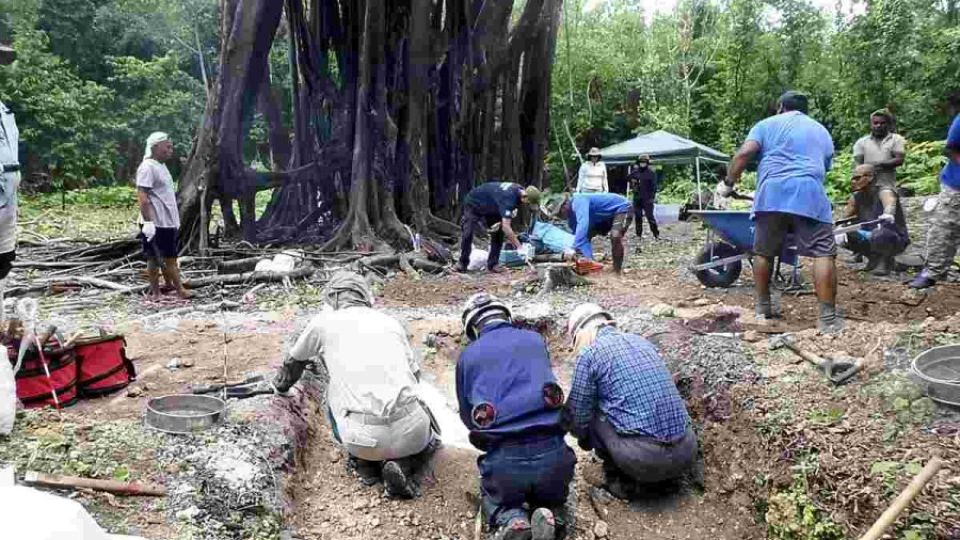December 4, 2024
TOKYO – A mass burial site where the remains of Japanese soldiers were interred by the U.S. military on Peleliu Island, a fierce battleground during the Pacific War, has been definitively located. Japan’s Health, Labor and Welfare Ministry will begin full-fledged collection of remains there on Sunday. The island is now part of Palau.
U.S. documents record that 1,086 bodies were buried there. It is extremely unusual to collect remains from a burial ground of such a scale. The families of Japanese soldiers who died on Peleliu have high hopes for the return of their remains.
In 2013, a memorial group formed by the families and comrades of the soldiers who belonged to the 2nd Regiment of the Mito Infantry, which was stationed on the island, obtained a map of the mass burial site from the U.S. Navy Seabee Museum in California and provided it to the ministry. Subsequent research by the ministry uncovered U.S. military documents and other information that indicated 1,086 people were buried there.
Based on such information, the Japan Association for Recovery and Repatriation of War Casualties, which was designated by the ministry as the operator of the project to collect remains, began its investigation. Since July last year, the Tokyo-based association has conducted trial excavations in more than 10 locations at the site.
In October 2023, the association found an area in the densely forested central part of the island where iron stakes had been driven into the ground at equal intervals as if to delineate a 900-square-meter area.
When the trees were cut down and the ground was dug up to a depth of 60 centimeters, the remains of two individuals were found in May this year, followed by five more in September. In three cases, complete skeletons were found laid out on stretchers.
The association official in charge of the project said: “The area around the site was covered with automobile wreckage and other debris, but there was nothing inside the area bounded by the iron stakes. We were convinced that it was a burial site in a special space.”
The ministry determined that the site was the mass burial ground indicated by the documents, in light of such circumstances as the remains having been neatly arranged.
About 10,000 Japanese soldiers died on Peleliu in the war, and the remains of about 2,400 of them have yet to be recovered. The ministry and other entities plan to send a 24-member survey team to the site, and are to begin full-fledged collection of the remains on Sunday.
The ministry intends to double the budget for collecting remains in Palau to ¥93 million in the next fiscal year, and the ministry official in charge said, “We will strengthen the structure for collecting remains before the 80th anniversary of the end of the war.”
The Yomiuri Shimbun reported in February 2015 the existence of documents indicating the mass burial site for Japanese soldiers on the island.
Peleliu, a western Pacific island measuring about 10 kilometers north-south and about 3 kilometers east-west, was under Japanese mandate from 1920 and became a military base. More than 40,000 U.S. troops landed there from Sept. 15, 1944, and 10,000 Japanese troops put up resistance, operating from caves. Organized fighting continued until Nov. 24, 1944, with only about 450 Japanese soldiers surviving.
In 2015, the then Emperor and Empress (the current Emperor Emeritus and Empress Emerita) visited the site for a memorial service.
Collection of remains declines
Nearly 80 years have passed since the war ended, and the number of remains being repatriated has been decreasing.
According to the ministry, 2.4 million Japanese died overseas (including in Okinawa and Iwo Jima), and as of the end of September this year, the remains of about 1,123,000 had not been returned. Of these, 300,000 lie at the bottom of the ocean with sunken ships and others, and 230,000 are difficult to repatriate due to circumstances in the relevant countries.
The government is focusing on the remaining 590,000 remains and is proceeding with research and collection.
The government’s project to collect remains began in fiscal 1952, and the law for the promotion of the collection of remains of the war dead, enacted in 2016, states that the collection is the responsibility of the government.
However, the number of individuals whose remains were collected declined from 1,411 in fiscal 2014 to 139 in fiscal 2023. This is due to factors such as decomposition and the dwindling number of people with knowledge of burial locations.
Kazufumi Hamai, a Teikyo University professor who is knowledgeable about remains-collection projects, stressed, “Collecting remains is increasingly important to pass on the memory of the war to coming generations and face the horrors of the war.”
Hamai added, “In order to return as many remains as possible to the surviving families, it is essential to make full use of scientific knowledge, such as DNA analysis.”

